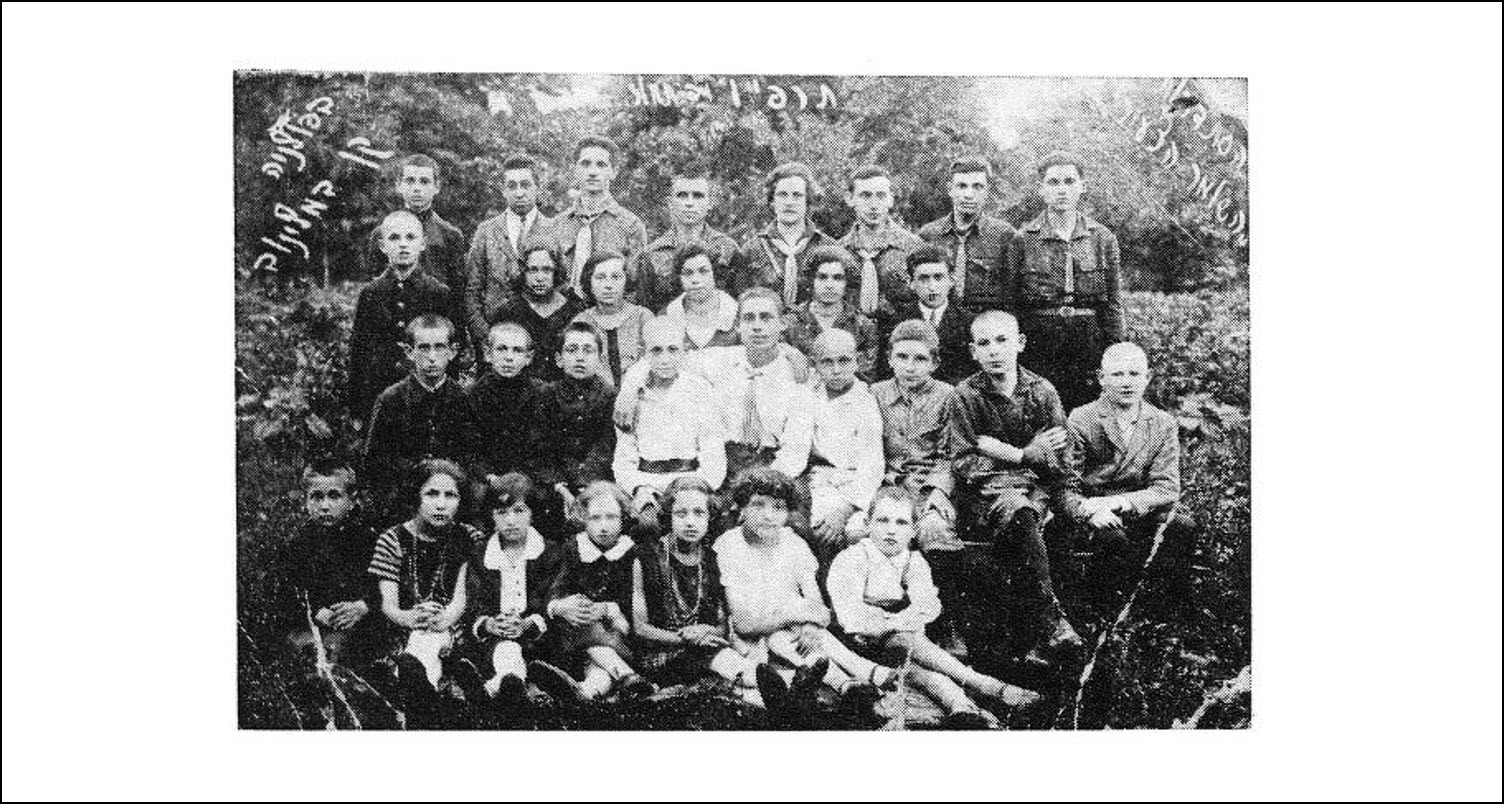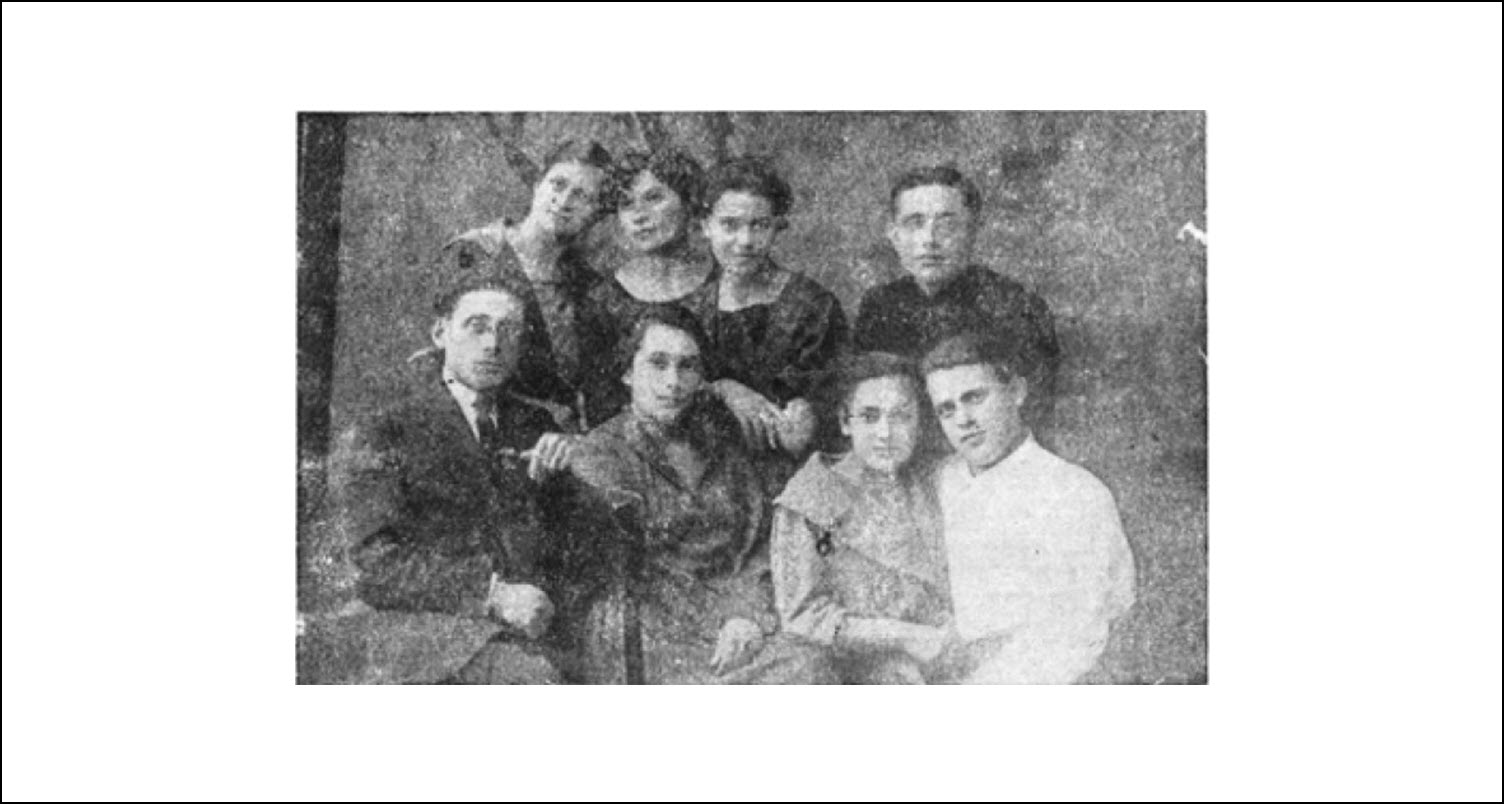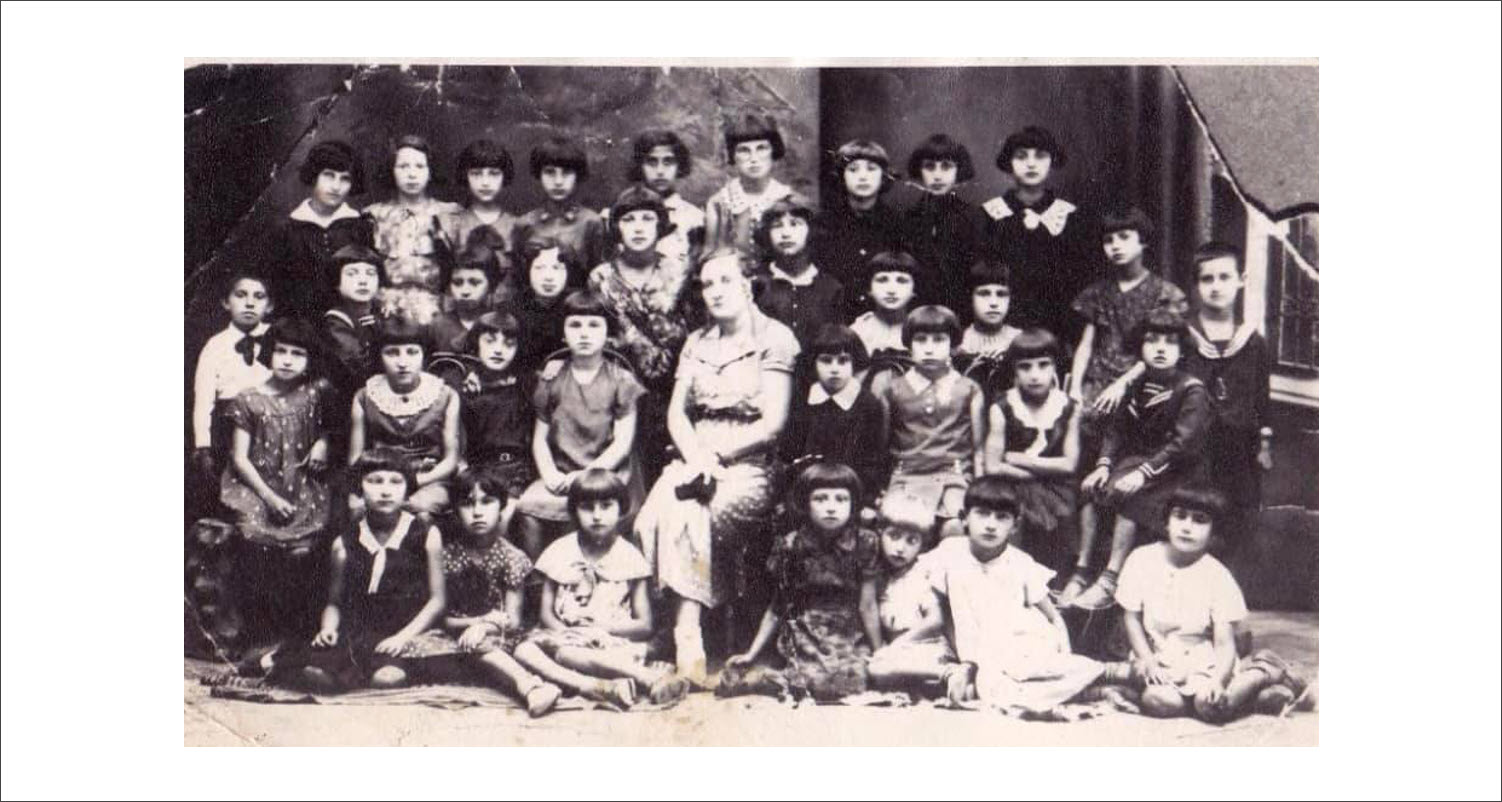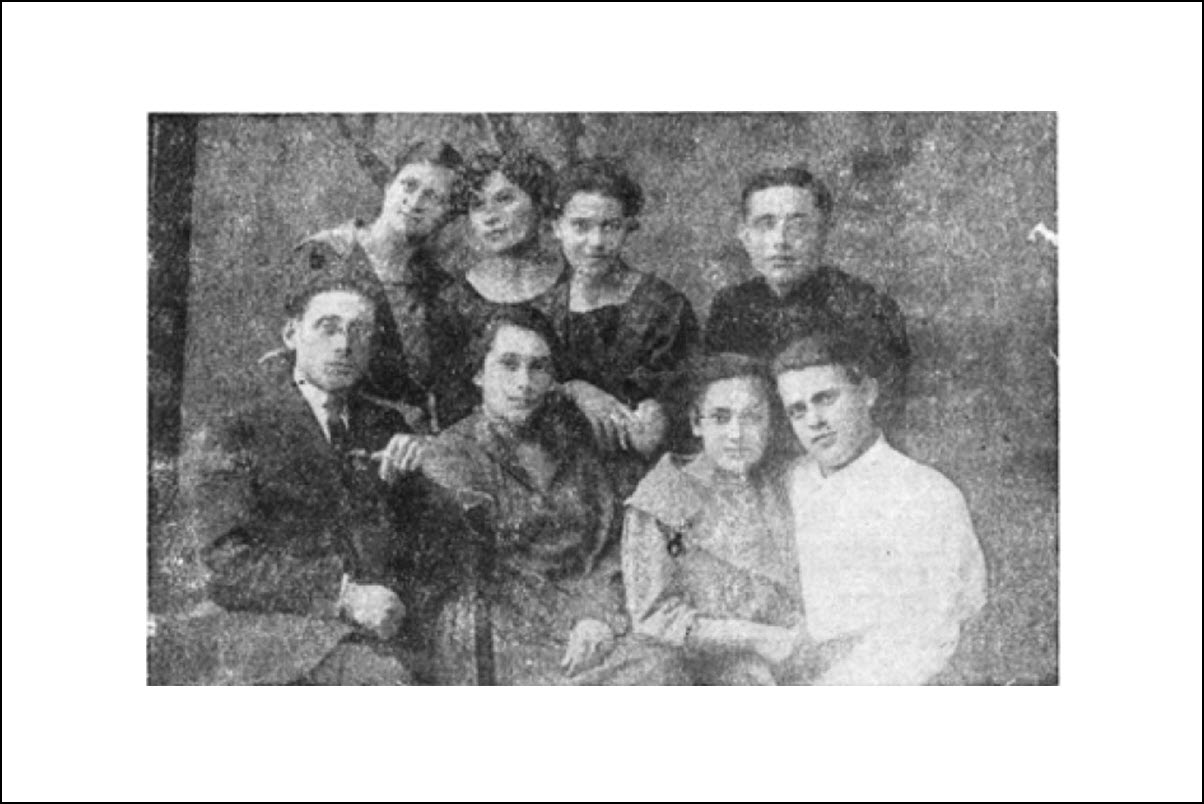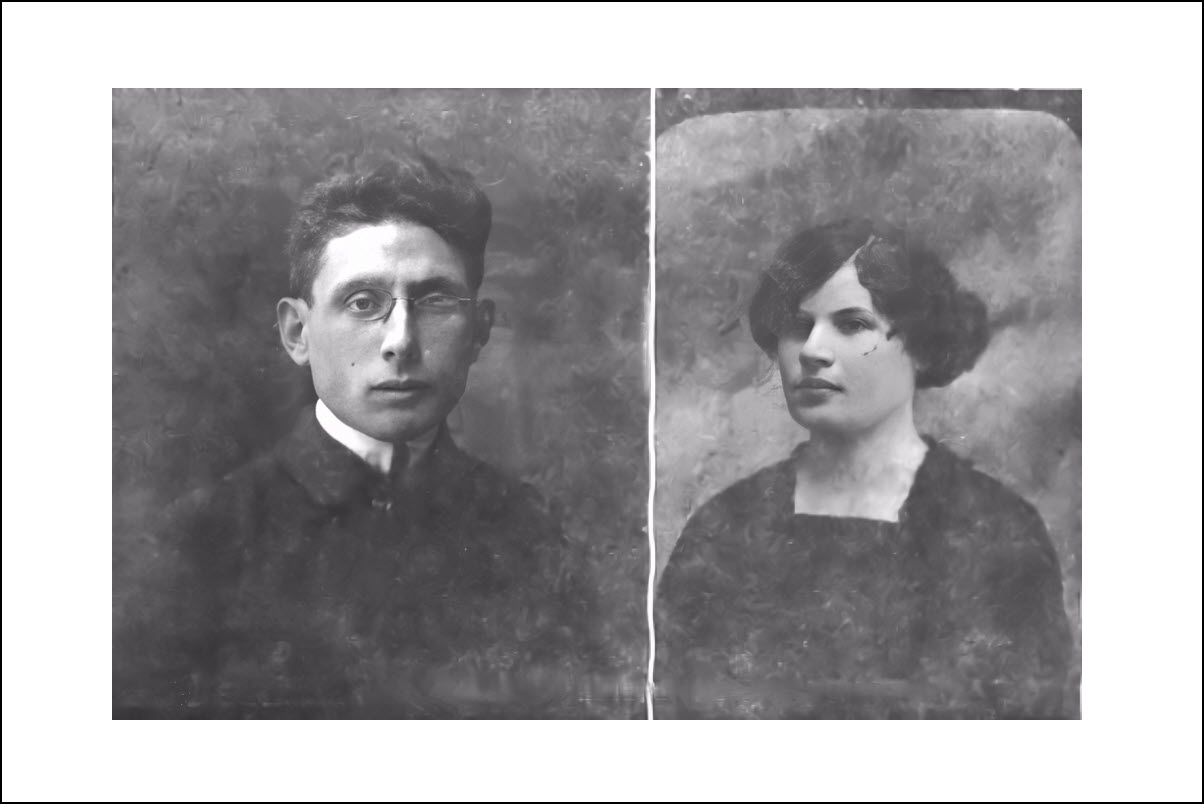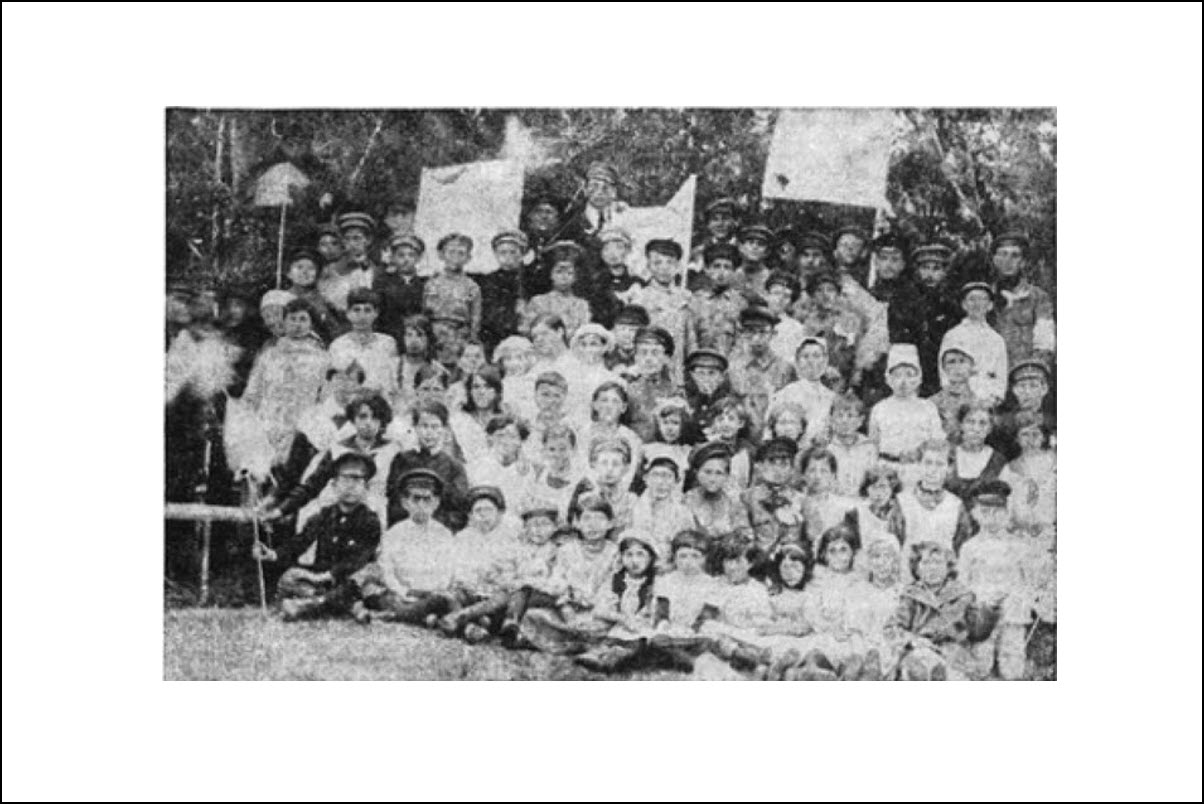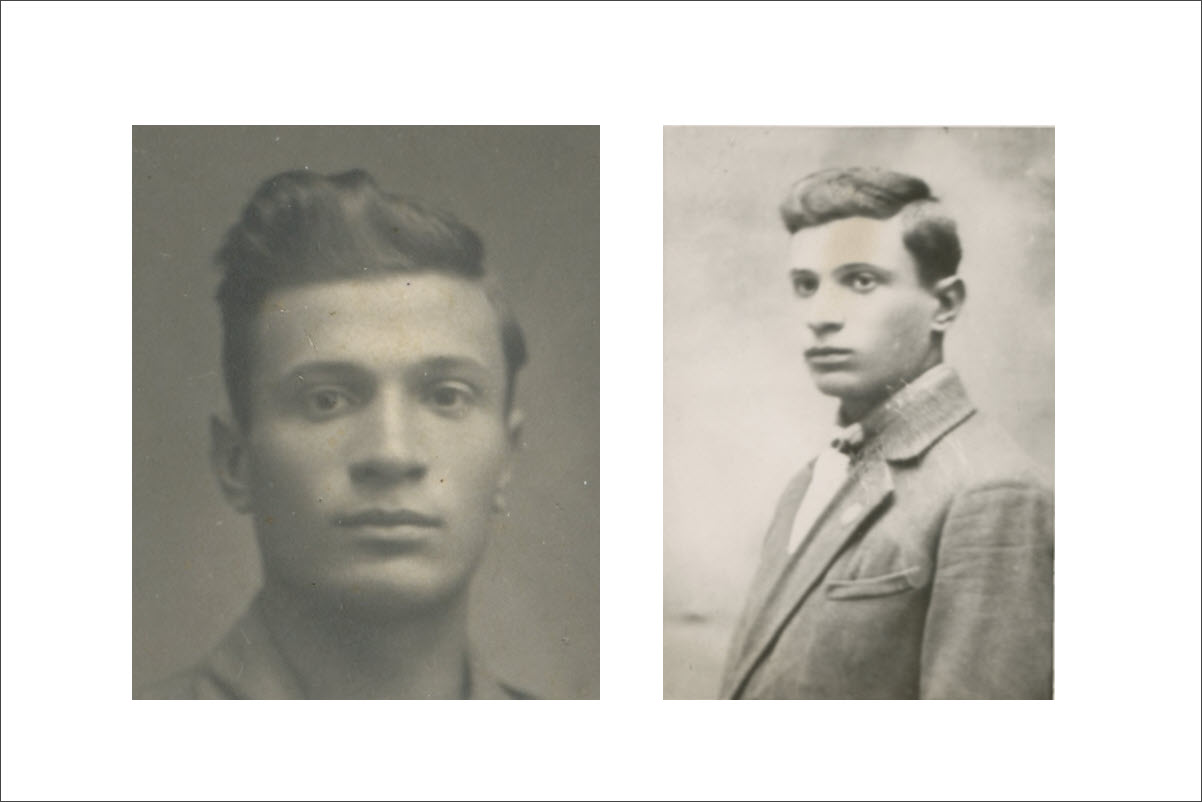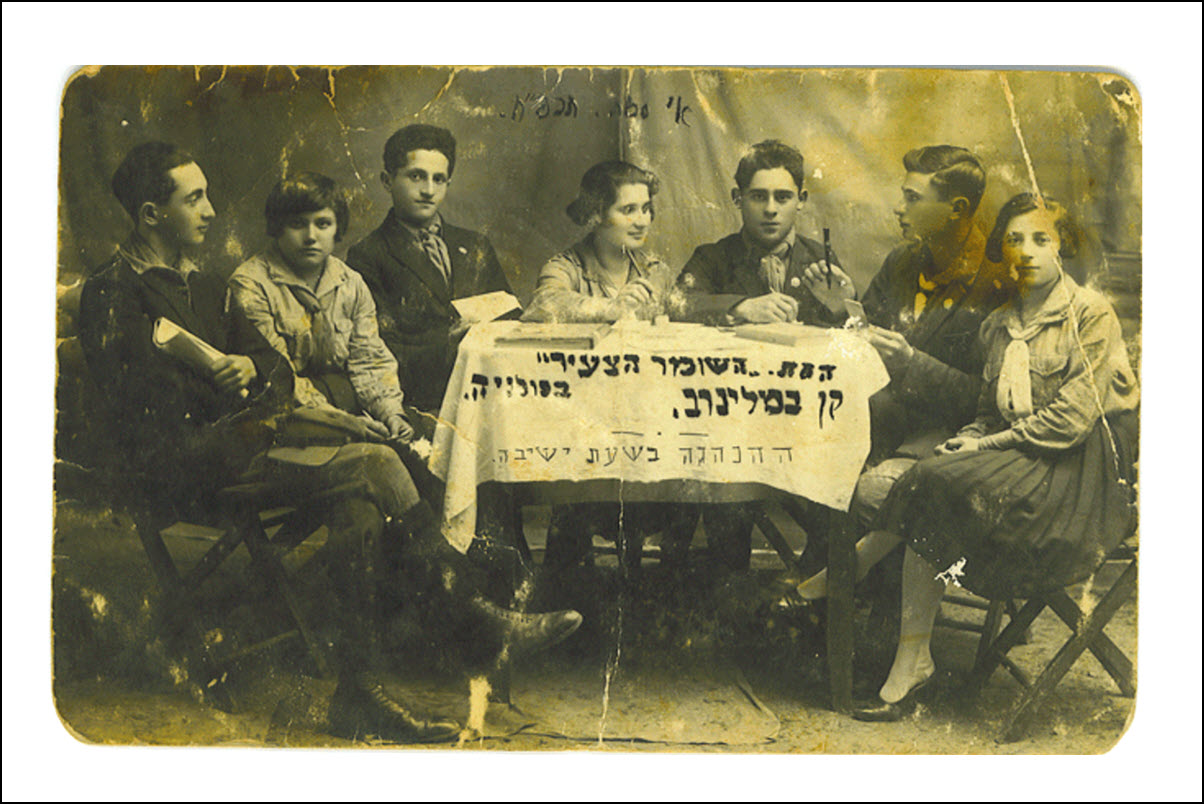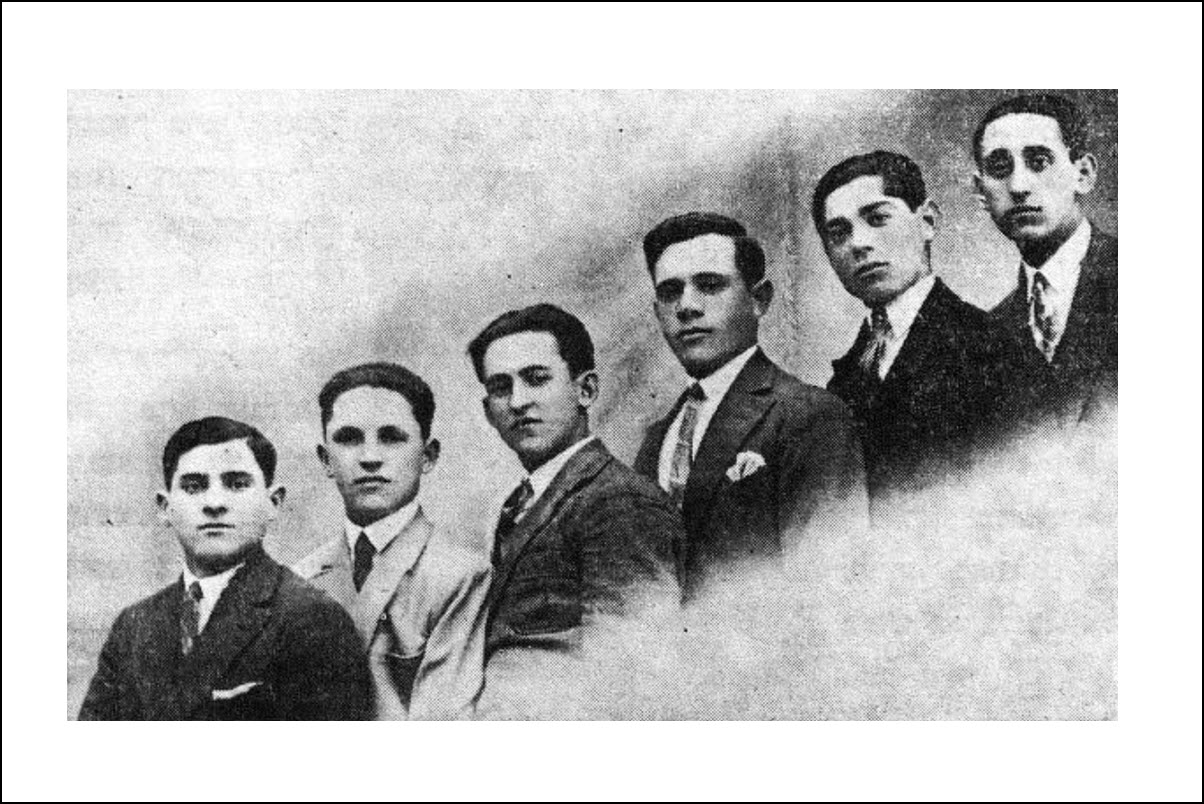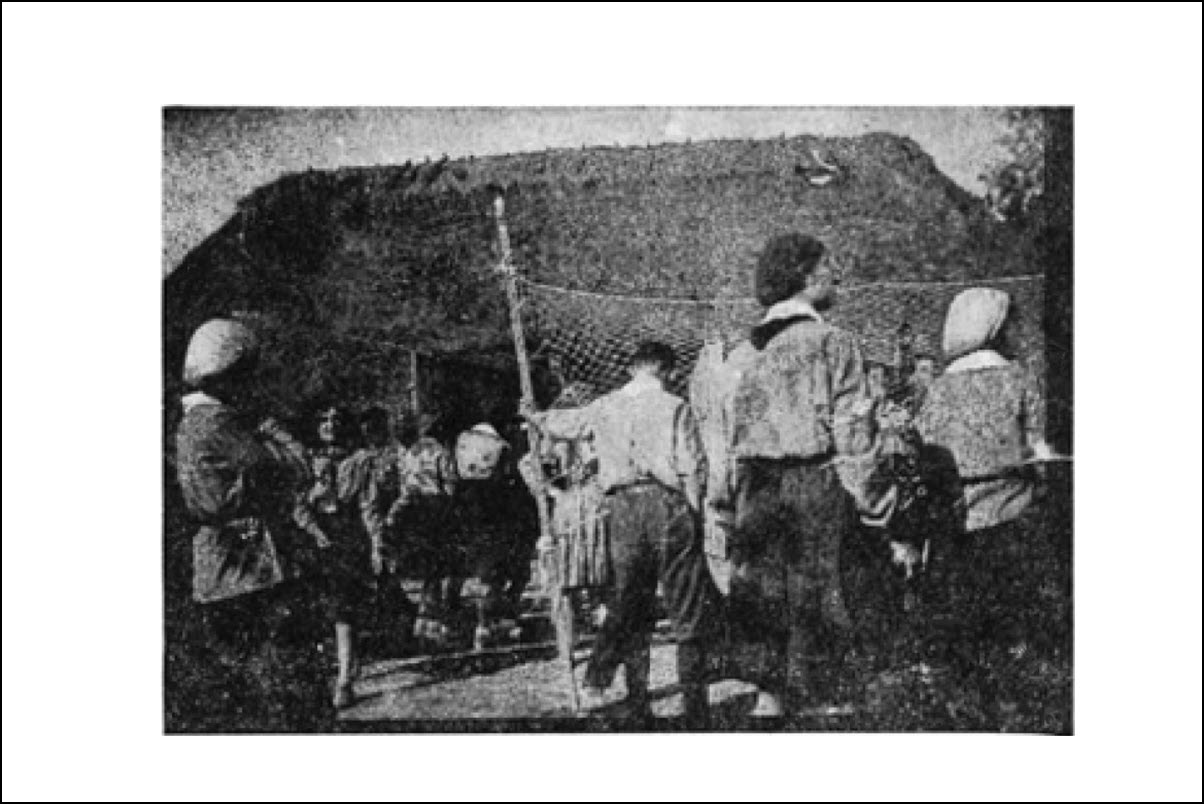-
Home
Home About Network
- History
Nostalgia and Memory The Polish Period I The Russian Period I WWI Interwar Poland 1944 Memorial Commemoration- People
Famous Descendants Families from Mlynov Ancestors By Birthdates- Memories
Interviews Memories 1935 Home Movie in Mlynov 1944 Memorial Commemoration Wall of Commemoration- Other Resources
. Mlynov and Mervits in Interwar Poland, 1918–1939

The Beginnings of Zionist Youth Groups in Mlynov
There are many references, throughout the Mlynov-Muravica Memorial book, to the growing interest in this period in Zionism and the Zionist youth groups and immigration to "the land of Israel" (still Palestine at the time). Indeed, the growing commitment to Zionism constitutes at least one of the major themes that threads its way through the Memorial book.
We learn from the stories and photos that many young people of Mlynov and Mervits were drawn to and involved in various Zionist youth groups during this time. There was in fact significant peer pressure in Poland generally during this Interwar period for young people to belong to and declare an allegiance to a youth group, even outside Zionist circles.[1] Some youth of the period acknowledged joining youth clubs out of peer pressure without at first even understanding the values endorsed by those groups. It was, as we might say today, “the hip or cool thing to do.” Many of the later reflections from descendants of Mlynov and Mervits families who left during this period recall the importance of these formative Zionist youth experiences in their lives.
“Zionist activities began in Mlynov before World War I, while the Czar was still in power” recalls Yosef (Joseph) Litvak, one of the editors of the Mlynov Memorial book, later writing from Jerusalem.
The Zionist activities of the town began in fact some time before WWI during the Tzarist reign. Already there was a group of young educated people, experts in Hebrew literature, who saw themselves as aligned with “Youth of Zion” (Tze'irei Zion). In 1919, moreover, the first immigrant to make aliyah from Mlynov, when he was 19 – the well-known poet Yitzhak Lamdan (the brother of my mother, the person writing this essay), who became very famous in the later part of the 1920s in Israel because of his poem “Masada.” [2]
The author of these memories was Yosef Litvak, who was born in 1917 in Kiev. His son, Meir Litvak, explained to me that Yosef's mother, Dvora Lamdan, was in fact a Mlynov girl, the sister of the poet. She moved to Kiev in 1911. A year later she married Mendl Litvak, Yosef's father. The Litvak family subsequently fled Kiev, however, because of pogroms and because Yosef's father worked for a wealthy land contractor and was considered bourgeoise by the Bolsheviks. They settled in Mlynov in about 1920. At that point, the family tried to get a visa to the US, but failed following the 1924 laws restricting immigration to the US.[3]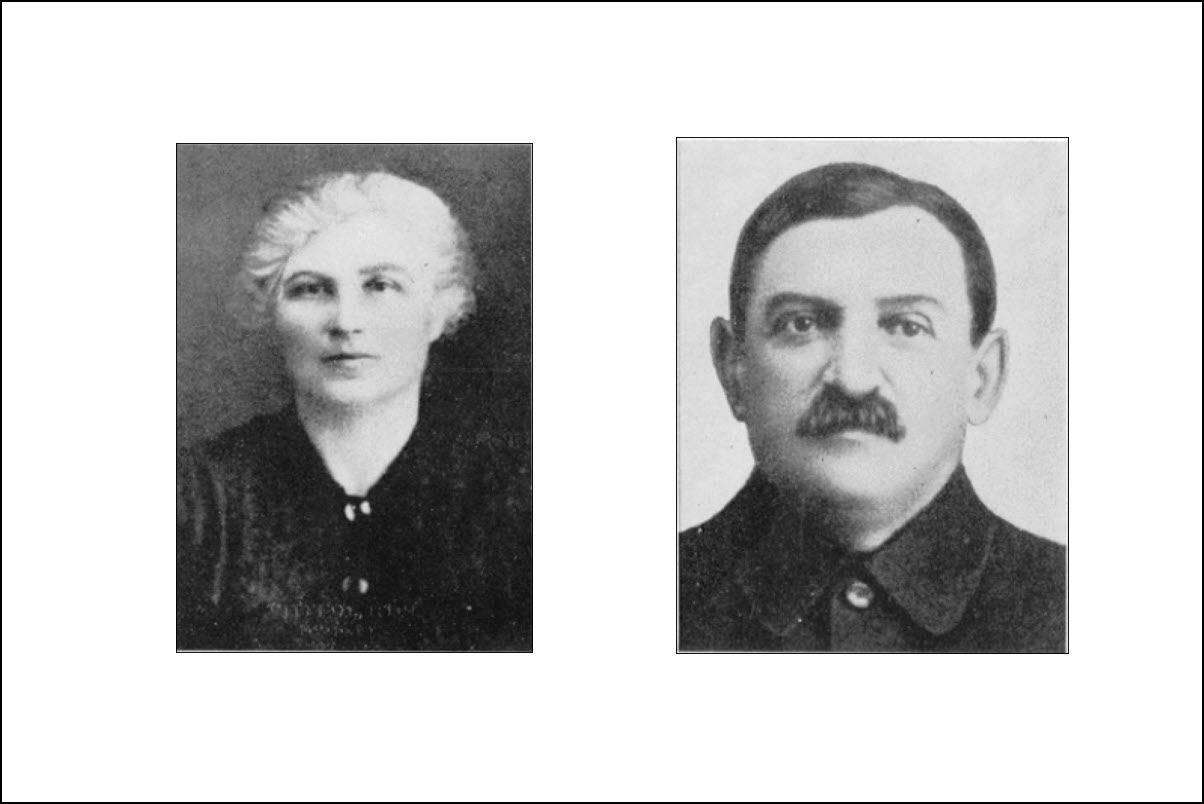 Yosef Litvak's parents, Motel Litvak and his wife Dvora Riva (Lamdan), sister of the poet Yitzhak Lamdan. Mlynov Memorial book, p. 454. Yosef contributed several essays to the Mlynov Memorial Book including "My Town Mlynov."
Yosef Litvak's parents, Motel Litvak and his wife Dvora Riva (Lamdan), sister of the poet Yitzhak Lamdan. Mlynov Memorial book, p. 454. Yosef contributed several essays to the Mlynov Memorial Book including "My Town Mlynov."In Mlynov, Yosef's son Meir explains, that
My father had been very active in Hashomer Hatzair, a Zionist left-wing movement, which was the larger youth movement there. In the 1930, the right-wing Beytar opened a branch in Mlynov, which was smaller. My father served as a group-leader and later as the branch sercretary in Mlynov. He tried fervently to get a certificate to Eretz Yisrael from 1936 to 1939, but failed because of British restrictions. Litvak was later been studying in Rovno (Rivne) when the Nazis invaded and managed to escape by fleeing east.[4]
Writing in 1970, Yosef Litvak recalls that the “atmosphere of Zionism was prevalent throughout the town. Most of the Zionist activity was centered in the youth movements. Older people were not very active in Zionist affairs, but they respected and supported anything related to Palestine, particularly immigration.”
Mervits was behind the times in this respect, recalls A. Gelman from Netanya, Israel.
The Jews of Mervits were tied to their town with every fiber of their being and only a few solitary individuals immigrated to the United States during the large migration of Jews of Poland and Russia – or made aliyah to the Land [of Israel] with the wave of immigration between the two wars.
Meanwhile, significant changes began in the towns of Volyn in our area. The youth established branches for each pioneer movement, established secular schools, which educated jointly with the pioneer movements, for aliyah to the Land [of Israel], but to our small town, these new winds [of change] barely arrived. The town continued the way of life that was customary before the War. At the center of life stood, of course, the small traditional study-hall [Bet-Hamidrash], which served as a place of worship and for the study of Torah. Also, [it served] as a meeting place both for elders and youth together for discussions of politics, and general subjects, during the secular days of the week but especially on the Sabbath and festivals."[5]
Eventually, however, the youth of Mervits got involved in the Zionist youth groups as well. Yaffa Dayagi, from Kibbutz Ramat David, also recalls that
By contrast, Mlynov was completely different. The effervescence of the youth was like that of the larger world; later this awakening began in this smaller town of Mervits. The children began to attend the school in Mlynov. The youth began to participate in the [Zionist Youth] movement and thus began the contact between the smaller number of youth in Mervits and the youth of Mlynov.[6]
There were other impulses too, besides Zionism, that initially brought the youth of Mlynov and Mervits together as well, such as the library of the Shulman house and hanging out along the Ikva river. But these appear to be superceded by Zionist youth clubs that came to dominate in the period.
The Shulman Library and the Haskalah Option
One of the most detailed accounts of the changes occurring in the towns is provided by Aaron Harari, later from Moshav Merhavia in Israel. Aaron Berger was born in 1908 and as a young man became one of the leaders in the Zionist Youth Groups in Mlynov. He changed his surname to Harari after he made aliyah in about 1934. Aaron, writing in the Memorial book, also recalls that the Zionist movement began to grow in Mlynov slowly after WWI and that a profound cultural and linguistic shift started to take place with this change.[7]Reading Harari’s account, I’m personally moved as he draws a contrast between the Shulman home, belonging to one set of my Mlynov great-grandparents, and the emerging Zionist impulse that was starting to take hold in the towns. As I read Harari’s account, I ponder the fact that the person I became was determined in many ways by the decisions and commitments of my great-grandparents back in 1921.
Tsodik Shulman, my great-grandfather who oversaw the Count’s forest before the War, was the nephew of the famous Haskalah writer, Kalman Schulman, and brought with him Jewish enlightenment ideas to Mlynov where he married Pearl Demb. The Shulman library apparently was known for its embrace of Russian literature and was a congregating place for young people from Mervits and Mlynov, at least before the War.
Harari writes:
After the First World War, when most of the residents returned from their locations of exile as refugees and the small town had recovered from its destruction – the house of Shulman served as a cultural (tarbut) center in the town. This was a meeting house for all those seeking culture ("tarbut"). There was the library where they rehearsed plays and in a large-covered patio next to the house, performances were held.
Harari was not the only one to recall the Shulman library. It was also remembered as a teenage hangout in the oral traditions passed on by Ben Fishman. Ben told his son Ted that the only reason he was allowed to hang out with the Shulman daughters was because Tsodik Shulman allowed the young people to socialize in the library under the guise of learning.Since all of them were absorbed and influenced by Russian culture, the language spoken was peppered with Russian, and most of the books in the library were in Russian, and a few in Yiddish; there was not a trace of Hebrew books. The club, that centered on the Shulman house, was far from Zionism; and those that shied away from Russian culture, in the club mentioned above, were forced to look for another hangout.
The presence of the Shulman Russian library testifies to the presence of Haskalah (“enlightentment”) ideas in Mlynov at this time. There are photos of young people in the Memorial book labelled "maskilim" ("enlightened ones"), but it is difficult to know if this reflected an embrace of "haskalah," (the word for Jewish enlightenment) in the town or was just a term used for "studious" young people. We don’t hear much about such ideas afterward, and it is difficult to know whether they were no longer present or those who embraced them were among those who didn’t survive. We may never know.
The contrasting choices facing the Mlynov and Mervits communities after the war were stark. Ben Fishman left for Baltimore in 1920 with the three families that joined Itzhik Lerner, the Mlynov immigrant to Baltimore, who had come back to Mlynov in 1920 to assist his family get to the States. In 1921, the bulk of the Shulman family left for Baltimore and there Ben subsequently married Sarah Shulman whom he must have been courting in the Shulman library.
That same year, Ben’s parents and siblings went the other way. Moshe Fishman left for Palestine and is remembered in the Mlynov Memorial book as the first family to make emigration up to the land of Israel ("aliyah"). What a stark indication of the dramatic choices facing the refugees who had returned after the War in the newly born Poland. Those choices would become more limited soon as the US imposed its immigration quotas. This was one of the factors that led to the increase of emigration to Palestine, among others, as discussed more below.
***
The Growth of Zionism in Mlynov
Harari recounts the growth of Zionism in Mlynov and the cultural shift that took place.Very slowly a Zionist club crystalized which espoused Hebrew culture and at its center was Samuel Mandelkern.[3] A modern Hebrew school, “Tarbut” (Culture), was established. Many children, who previously studied in heder, transferred to study in the school. They were led by an instructional system that was adopted in the schools of the cities and towns. They brought two teachers from outside. Jacob Eisenberg from Rovno (today – [surname] Eshed, in Ein Harod Meuchad) and the teacher Penina from Varkovitchi. In addition, the local teacher was Malcah Lamdan, sister of the poet, Yitzhak Lamdan, z”l, and wife of S. Mandelkern.
Joseph Litvak writes:Around this school, educational and cultural work was concentrated and flourished. In the evenings, there were lessons for adults, a foundation was put in place for a Hebrew library, and a choir was organized and conducted by Pesach Zutelman. We organized parties in which students dressed up in costumes [drawn from] lives in the Land [of Israel] and choirs with songs from the Land [of Israel]. This was a shining period in the lives of the shtetl youth. The animating spirit in all these activities was again Samuel Mandelkern, without him nothing would have gotten started. He was a person of energy and his initiative had no limit.
I remember the day that the Balfour Declaration was celebrated. There was a large parade in the streets of the shtetl in which all strata of the people participated. The shop owners closed their shops, the artisans left their workshops, the women left their housework – and they all came out to the streets. At the head of the parade was a company of youth riding on horses with flags of blue-white in their hands.[6] Following them, marching in order, the choir, singing Hebrew songs, students from the school, and after them the bulk of the public. The gentiles came out to the street and with surprise watched the Jews in their Palestinian celebration. The chief of police, who was friendly with the local movers and shakers, supervised the order.
We celebrated nearly every Zionist and national event which took place with a very impressive appearance and a large participation. I also remember the banquet, that was put on for the dedication of the Hebrew University on Mount Scopus (Har HaTzofim).[7] This was organized in good taste, and participation included local government officials and honored individuals who were invited as well as educated gentiles. In addition to the gastronomic program, there was an art program that enchanted all those present.[8]
Only when life returned to normal after War World I and the Polish-Russian War, in the years 1921/22, were the youth movements, “The Pioneer” (HeHalutz) and the “Young Guard” (Hashomer Hatzair), organized. In 1924/25 all the local youth, ages 18-30, were signed up in The Pioneer (HeHalutz) and in the local “Palestine Office” – of which my father was the director and which set up our small apartment for no fee on its authority.
Yaakov Holtzeker (also Goldseker), writing from Tel Aviv, has a similar recollection of multiple Zionist Youth Groups and their social function: "In Mlynov there were several Zionist movements, like The Young Guard (Hashomer Hatzair), Betar, and others. We used to get together to have a good time, read books, and hear various Zionist speeches. There were also excursions. On Lag B'omer, for example, we used to go into the nearby forests and have fun a whole day, returning home at night. In the winter young people would take sleds down the mountains in the moonlight. The political parties used to organize various events and plays."[10]These youth had serious intentions, and all were ready to make aliyah with no additional prompting. There were many younger people who “forged” their age and registered as age 18 with the hope they would be able to make aliyah. The most substantial activities were brought to light by “The Pioneer” (HeHalutz) branch, which had majority and best of the youth involved. During the decade from 1926-1936, the youth clubhouse bustled everyday from late afternoon until late in the evening, and alone served as the center of light and hope for Hebrew youth in a cruel and depressing reality, which already by then hinted of the coming destruction which was imminent.[9]
Samuel Mendelkern, who is mentioned here as a leader in the Zionist youth groups, was among one of the first to migrate up (aliya) to the land of Israel in 1925, then Mandate Palestine.[11] Mandelkern married Miriam Lamdan, the sister of the famous poet, Yitzhak Lamdan, and Samuel's sweetheart from Mlynov. The young Samuel and Miriam appear in a number of photos in the Mlynov-Muravica Memorial book.
***
When Samuel and Malcah Mandelkern made the decision to make aliya they made a deep impression on the younger Mlynov youth, including Yehuda Mohel who had only recently moved to Mlynov from Boremel, a nearby town. Mohel, whose own compelling story will be recounted below, recalls their leave taking vividly.
In those first months in that town (Mlynov), I remember an incident involving one of the inhabitants whose name was Shmuel Mendelkorn and who left the town with his wife Malka. That was in 1925. His wife was the sister of the poet Yitzchak Lamdan who also lived there. That same Shmuel and his wife went to the land of Israel. It was a very important event in my life. Even in Boremel occasionally someone would leave to go and live in Israel. Shmuel Mendelkorn was not really an acquaintance and he was also much older than me; he was the brother of a girlfriend of mine... There was a very large party before he left. Of course, I was not invited, but nonetheless, together with Yona-Reuven, we wrote a farewell poem, and the first letters of each line formed Shmuel’s first name and surname. We sent this poem to him, with a messenger, to the party, but of course, we never received a response.[12]
Mandelkern made a lengthy contribution to the Mlynov Memorial book himself. Writing in Tel Aviv in 1970, he recalled the earlier period during 1916 during WWI when a self-defense league was formed to protect the towns from pogroms, and which provided the young people "a form of entertainment and socializing." This appears to be the seeds of the Zionist Youth groups that blossomed after the War.[13]
Mandelkern was also central in staring another institution in Mlynov. Litvak writes:
The activities that were blessed were brought to life by the Tarbut, [“Culture”] branch, which was established by Samuel Mandelkern, one of the first pioneers of all the local Zionist activities and one of the first to make aliya to the Land [of Israel] (1925), who lives today in Israel in Tel Aviv and continues his fruitful public activities. In fact, this branch failed to establish a local Hebrew school officially recognized [by the Polish government], but he managed, with the help of the youth movements, to spread knowledge of Hebrew with great success. Every young local Jewish person knew Hebrew. The activities of the youth movement were conducted almost entirely in Hebrew.[14]
***
Cultural and Zionist Organizations: Tarbut, Hashomer Hatzair, HeHalutz
The establishment of Tarbut school in Mlynov was one of several indications of the growing shift from Yiddish and Russian to Hebrew, and the growing impact of secularizing and nationalistic ideologies. We know that beyond Mlynov, the ideological debates over language were fierce and had started in the Russian Period. The Jewish Socialist Bund, which was strong in Interwar Poland, favored Yiddish, the language of the people, whereas the Zionists of all flavors favored Hebrew as the language of their national identity. The debate over Hebrew versus Yiddish was thus the expression of deep underlying ideological commitments and visions. The Bund did not embrace the idea of a Jewish national state and emphasized that class conflict would lead to an amelioration of the Jewish Question. The blend of Socialist Zionism brought a class oriented perspective into Zionism itself and reconciled what at first seemed to be diametrically opposed ideological positions. As we shall see, one of the more important youth groups in Mlynov and Mervits during this time had its origins in a Socialist Zionist perspective.
The Tarbut school system proved to be one of Zionism’s biggest successes in interwar Poland.
Tarbut was a network of secular, Hebrew-language schools in parts of the former Jewish Pale of Settlement, specifically in Poland, Romania and Lithuania. It operated primarily between the world wars. The first Polish national Tarbut conference was held in Warsaw, in December 1921. Eventually the Tarbut network, which was supported by Zionist groups, encompassed kindergartens, elementary schools, secondary schools, teachers' seminaries, adult education courses, lending libraries and a publishing house that produced pedagogical materials, textbooks and children's periodicals.[15]
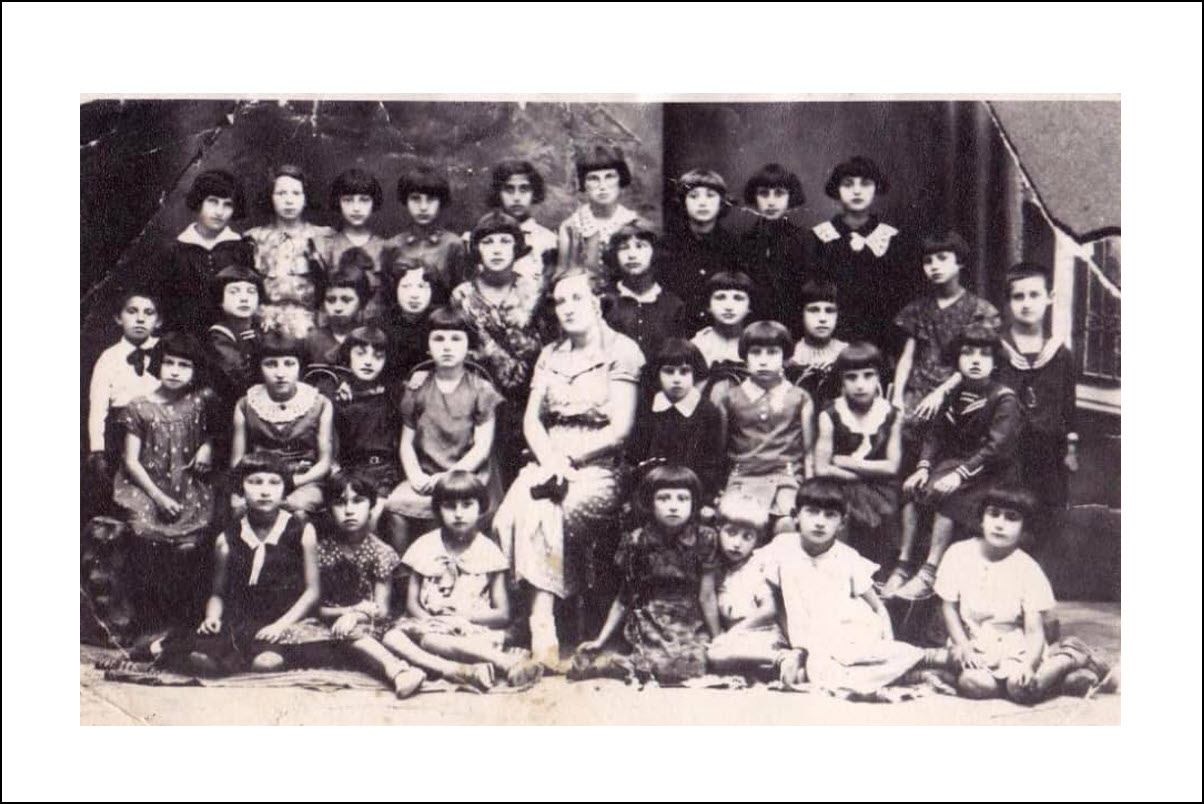 Genya Kozak (later Jean Litz in America) is seated on the floor on far right. This photo circa 1933 shows a group of Mlynov and Mervits youngsters in a Hebrew class. Genya was 13 when the Nazis came into Mlynov and was the only survivor known from this photo. Chana Klepatch also appears in this photo, in second row third from left. Photo courtesy of Miriam Litz.
Genya Kozak (later Jean Litz in America) is seated on the floor on far right. This photo circa 1933 shows a group of Mlynov and Mervits youngsters in a Hebrew class. Genya was 13 when the Nazis came into Mlynov and was the only survivor known from this photo. Chana Klepatch also appears in this photo, in second row third from left. Photo courtesy of Miriam Litz.Joseph Litvak writes about the activity of Tarbut in Mlynov at the time:
After a few years, the branch [of Tarbut] established a Hebrew kindergarten. The entire time, until the destruction, a large library was established that had Hebrew, Yiddish and Polish books. This library served as the only source of knowledge for the local youth, because in the small town there was only a government-sponsored grade school and not even one Jewish family sent their children to high school outside the small town. Under the rubric of “Tarbut” (Culture) along with the youth movements, they put on question and answer evenings, literary judgments, and dramatic plays. The Zionist activities and influence on the Zionist youth movements diminished in the last three years before the outbreak of the War, principally because most of the activists with leadership ability made aliyah to the Land [of Israel].[16]
Harari notes that, “some of the teachers in the Tarbut Hebrew School and nursery were members of the Hashomer Hatzair (“the Young Guard”), one of the more popular youth groups in Mlynov and Mervits, as we shall now see.Hashomer Hatzair
HaShomer Hatzair, the most popular group in Mlynov and Mervits, was a secular Socialist-Zionist youth movement founded in 1913 in Galicia, Austria-Hungary. Initially Marxist-Zionist, the movement was influenced by a range of ideas and figures such Ber Borochov, a Marxist Zionist and one of the founders of the Labor Zionist movement and, Baden-Powell, the British Army officer, writer, and first Chief Scout of the world-wide Boy Scout Movement, which was getting going in 1907. Hashomer Hatzair held that the liberation of Jewish youth could be accomplished by aliyah (“ascent”) to the land of Israel (Ottoman Empire at the time) and living in kibbutzim, working the land and in the setting of shared ownership. After the First World War, the movement spread to Jewish communities throughout the world as a scouting movement.[17]
Aaron Harari's Reflections
Aaron Harari gives the most detailed history of HaShomer Hatzair in Mlynov. He recalls that“Hashomir Hatsair” was founded in Mlynov in 1920 by a man from Rovno named Lemel Rosenfeld. Originally, two groups were established, one for children aged 15–16 years old, and the other for those 12–13 years old. Only boys were allowed to join at that time. Most of the activities consisted of military exercises such as marching drills. All the orders were given in Hebrew, and all conversations and discussions were held in Hebrew.
Who were the guides who immigrated to Argentina? We know that between 1923–25, a number of Mlynov and Mervits boys left for Buenos Aires on their way to the United States, which had imposed immigration quotas. Perhaps some of these young men were the guides that had been involved in Hashomer Hatzair.The initial establishment of “The Young Guard” (Hashomer Hatzair) in the small town was in the summer of 1920 by a young man from Rovne[2] by the name of Lemel Rosenfeld, who visited as a guest with the family of Chaim Berger. As himself a member of The Young Guard, he organized around him a number of friends his own age and he led them in activity; afterwards they continued on their own.
In the “nest” then there were two groups, one of older youth – ages 15–16, and the second younger, ages 12–13. The two groups were comprised of boys only. I belonged to the younger group, which numbered 10 boys. I remember the first meeting, that took place one evening in the classroom of the Hebrew school. David Maizlish, z”l, spoke to us and explained to us the essence of The Young Guard and its true ethical significance for Hebrew youth. His words kindled sparks in our hearts and breathed new life in us. A sacred trembling and an adult seriousness passed over us even though we were still young lads.[18]
In any case, Harari helped revive the group in 1925. He wrote a letter to 'Hashomir Hatsair' headquarters in Warsaw asking for assistance in re-establishing the youth movement in Mlynov. Headquarters responded favorably sending him a great deal of information and many brochures. But Aaron did not know how to go about organizing the group on his own. So he publicized the idea in the synagogues, requesting all interested boys and girls in town to participate in the movement.
This approach turned out to be quite successful, and within one week, tens of boys and girls applied for membership into the movement. Once again, two groups were established based on age. They met on Saturdays in one of the forests outside of town. This time, however, the activities were more diversified than in the past, and the groups would sing songs, play games and sports, and read brochures and books about events in Palestine at that time. A tremendous feeling of unity developed among the members.
Harari recalls that in the spring of 1926, he went to Rovno [Rivne] to attend a Hashomer Hatzair convention. Leaders of the various chapters of Hashomir Hatsair in the area were in attendance. The convention presented many lectures on educational difficulties and organizational problems among the chapters. From this, Aaron learned how to become a more effective leader. When he returned to Mlynov, he appointed several members to be guides, and they resumed having meeting in homes. Harari recalls that the members of 'Hashomir Hatsair' wore special clothing which bore the emblem of the organization. During the summer, they held their meetings outside, usually in the forests; and in the winter, they met indoors. Occasionally, members from the Warsaw headquarters and even the land of Israel visited the group to discuss the essence of the youth movement, the goals of the group, and how to make their ideas come to fruition.
It is clear that Zionist youth activites in Mlynov and Mervits were tied tightly into the youth culture and socialization of young people of the town. It was a social club as much as a political movement. Harari recalls that:
Samuel Mendelkern, mentioned above, also established the amateur Jewish theater, which existed for several years. He served as the theater director, producing shows of very high quality. With regard to sports, the Jewish youth were involved in swimming, row boating, volleyball, bicycle riding and ice skating. They participated in these activities individually or with friends because there were no organized teams in the area.[19]
There are many photos of informal and organized youth groups that have come down to us from the interwar period in Poland. We see the youth were not in traditional religious garb; they socialized in mixed gender groups, the young males all had clean shaven faces, and some even shaved heads, a significant contrast with the older generation from the same period. Some of the youth in the photos can be see in scouting style uniforms with the kerchiefs. The youth had embraced various aspects of Polish culture and the youth movement.***
The Story of Yehuda Mohel and Hashomer Hatzair
A young man at the time, Yehuda ("Yudke") Mohel, who had only recently moved to Mlynov, has similar memories of Hashomer Hatzair in this period. It is worth spending a bit of time on Yehuda's story as he has provided one of the most detailed accounts of Zionist youth experiences in Mlynov in English. He also a quite amazing life: starting from his early rebellious vegetarianism, his involvement in Hashomer Hatzair and aliyah to Mandate Palestine, his subsequent involvement in the Communist Party in Palestine, leading to his imprisonment and deportation by the British, and his subsequent imprisonment in Poland after arriving there. When eventually freed, he returned to Mlynov with his new wife only to escape from the Nazis, treking through Siberia, and eventually fighting in the Polish army. In 2019, I tracked down his son, Dani Tracz (formerly Issachar Mohel), who provided the background for Yehuda's story, which is published in English.[20]
Yehuda was about 17 years old when the Mohel family moved to Mlynov in about 1924–25. He was born in 1908 in Boromel, a town not far from Mlynov, where his father, Eliezer Mohel was a shochet (kosher slaughterer) and sometimes known as "Rabbi Leizer Shochet." In Boromel, there were three approved shochets but after the War there wasn't enough business to go around. The Mohel family couldn't afford to own a modest house there because Yehuda's father, Eliezer, was the newest of the town's shochets and therefore had the least stable business. As his son Yehuda recalls, "it was my father's fate to leave."
Yehuda's father heard about a position for a shochet that had opened up in Mlynov, where there was only one shochet at the time ("Rabbi Pesach") and Yehuda's father was to become the second shochet of Mlynov. The possible reason for this new opening in Mlynov will become apparent below, as we tell the story of Bunia Steinberg, another member of the Zionist youth groups at that time. Her father became a butcher and shochet in Mlynov after the War against the advice of the local rabbi. After accidentally cutting himself and seeking medical treatment in Dubno, her father died due to an infection (there being no antibiotics at the time). I recently made the connection between these two separate family stories that I had learned about and that had been passed down in their families unbeknowst to each other. It made me wonder if the young Bunia Steinberg and Yehuda Mohel felt awkward around each other over this trajedy that had brought them into each other's orbit.
Back in Boromel, Yehuda's father, Eliezer, made an agreement to be bought out by the other two shochets in Boromel. With the money he made, the family was now able to purchase a nice house in Mlynov, which was a smaller town and where the cost of living was lower.
Yehuda had no friends or other family when he arrived in Mlynov in 1924–1925. But he had earlier been involved in Hashomer Hatzair back in Boromel and would now get involved in the organization in Mlynov as it revived. He recalls:
In the spring, I think it was in 1926, when the snow began to melt and the marshes dried up a bit and it was possible to go out and make contact with those around, I too began to go out and meet other young people. I learned that the Hashomer Hatzair organisation met in Mlinov. Although it didn’t really "exist", it had not completely disappeared, and there were youths looking for things to do. One of the leaders of this movement then was Aharon Berber (Harari), today [1970] living on Kibbutz Merhavia, as well as a few other people. Together with this group, we started to work for the revival of the movement’s activities (the "nest"). Over time, I was elected as secretary of the nest, and Aharon was its head, and that’s how we worked together during this period that I lived in Mlinov.
Yehuda also remembers Hashomer Hatzair serving an important social function for the youth and captures some of the military metaphors used to describe the group's organization: The Mohel family’s small courtyard in Mlinov. Yehuda’s three sisters (from right to left): Batya, Dvorah, and Chaya (standing). On the windowsill, Batya, a friend, and future wife of Yehuda's brother Yaakov, circa 1930s. See Mlynov-Muravica Memorial Book, p. 375 [orig. 411]. This original photo courtesy of Dani Tracz (Issachar Mohel).
The Mohel family’s small courtyard in Mlinov. Yehuda’s three sisters (from right to left): Batya, Dvorah, and Chaya (standing). On the windowsill, Batya, a friend, and future wife of Yehuda's brother Yaakov, circa 1930s. See Mlynov-Muravica Memorial Book, p. 375 [orig. 411]. This original photo courtesy of Dani Tracz (Issachar Mohel).We started to plan the activities and set up groups and brigades. Our activities were successful and we established a large and broad movement. About 90% of the youth in Mlinov belonged to Hashomer Hatzair, from the age of seven or nine to the age of 18–19 years old. There were groups of different ages, and all the activities were conducted in Hebrew – lectures, discussions. Everyone knew the language. We also established a small Hebrew library and we were associated with a nearby nest in the city of Dubno which was larger. There the nest was older and more developed and we learned a lot from them. They would come to visit us and help us with our work. The head of the nest in Dubno was Moshe Margalit who now lives at Kibbutz Shaar HaGolan.
Intergenerational tensions in Mlynov are also evident in Yehuda's reflections on the group's activities. These differences are framed in religious terms, but there were other generational differences as well. Yehuda is an interesting case in point.Earlier in life, Yehuda recalls how he became a vegetarian when he was living in Boromel. As one can imagine, this commitment was perceived as a significant slap in the face of his father, who was a shochet. How could the son of a kosher slaughterer become a vegetarian? Yehuda recalls the impetus for his vegetarian impulse: the moment that the family killed the chickens which Yehuda had become very attached to, having raised them at the home from chicks. One can imagine the psychological overtones in these small religious towns of rejecting one's father's profession of shochet by refusing to eat meat. With these intergenerational tensions in place already, it was natural enough for Yehuda to take part in a youth movement that was itself defining itself over against the parental generation. Yehuda recalls:
The activities of the nest, which developed well as I said, caused some resentment among the religious community; not only in general, but also among individuals whose parents objected to it. Sometimes, in the synagogue for example, voices of protest would be raised against the anarchy of the nest members, their desecration of the Sabbath by going on trips, or teaching the children not to honour their parents. I remember it was a movement of rebellion, a movement which considered itself to be revolutionary...
There were other clashes between the older generation and the younger generation. I remember one teacher in the school, a private tutor, who was a blatant atheist. He cooperated with us to a certain extent. He was very pronounced in his scepticism. Once he told us he would like to give a talk about atheism in the synagogue. This was, of course, chutzpah, and now I believe that it was not the proper thing to do...But then we were young, and we supported him and organised the lecture. All of the young people stood like a wall behind him surrounding him, because we knew that the religious people would start to attack him, perhaps even beat him...All of this reflected the desire of the young people to free themselves from the shackles of the past and to begin a new life.
Yehuda's reflections are consistent with the following characterization of Hashomer Hatzair youth in the earlier period of its formation and help explain what inspired them by this movement. Writing about the growth of this youth group in response to the dislocation of WWI and after, Elkana Margalit explains that:
It is not surprising that they were a grave, thoughtful, and introspective group, yet equally enthusiastic and full of faith, radical, thirsting for life, gay, and poetic. They longed for roots and community identification because they were tense, perplexed, rootless, isolated, lacking in security and without the least confidence in the maintenance of the contemporary social patterns and their own future social and professional status. As inner compensation they developed a sense of purpose, a belief in a communal mission requiring their personal dedication, fulfilment of their ideals in their own lives; fervent in their zeal and their desire to reassess all values, they were also anxious, tense, and restless, to a degree almost neurotic. They thirstily accepted all kinds of influences and contradictory ideas, no matter how superficial, and equally swiftly rejected them. They displayed considerable intiative and vitality, which found expression in the establishement of institutions, funds, journals and organizations, and in the emergence of a leadership. This was achieved with their own meagre resources, with virtually no assistance from adult society.[21]
As a young adult, with the family struggling economically, Yehuda had the yearning to be independent of his father. For a time he went to teach Hebrew in the nearby villages:But it did not give me satisfaction and I wanted to return to activities in the movement and, especially, I thought that I must make Aliyah to Israel. This was in 1927 and I was 19, almost 20, and at this age in order to move to Israel through Hashomer Hatzair, one had to first undergo hachshara (training). I stopped teaching in the village. I returned home and decided I was going for hachshara. At the end of 1927 I left for kibbutz training which was located in a small settlement, Horyn, near Stolin. I was the first one from my town to do so.
Yehuda was in training for two years and that is where he met his future wife, Riva. The experience of "hachshara" was intense for these young aspiring Zionists:There [in Horyn], we worked in a sawmill. Twenty or so people were gathered there. We rented a place where we all lived. We all slept together in one room on the floor, on mattresses. In the morning, we all went out to work except for one person who would stay at home to cook the meals, tidy the house. The rest of us would work, sometimes not just one shift but two or three. None of us was used to physical labour and until we became accustomed to it, we suffered. But we got used to it. I worked there like that for almost a year. Then we were moved to another training garin (core) in the city of Siemiatycze which is today in eastern Poland, near the border with Belarus.
In the summer of 1929, Yehuda learned that the British government had approved a certificate for him to emigrate to the land of Israel. So he returned home for a short while, to his parents, to prepare for my Aliyah to Israel. It was during this time that there was a celebration in town of his imminent plans to make aliyah. You can see Yehuda in these two Hashomer Hatzair photos, the first from 1926, and the second in 1928 as the group got ready for their emigration to the Land of Israel. In the 1926 photo, you can see Yehuda standing in the back row second from the right. In the 1928-29 photo, you can see Yehuda sitting in the centre, wearing a white shirt. His sister Bayta is sitting to his right. His other sister Dvorah is sitting in the row in front of him, second from the right. His brother Yaakov is standing on the right with a white tie.In Siemiatycze, we worked in a plywood factory. It was the winter of 1928–1929, one of the coldest winters. The temperature reached minus 30–40 degrees that winter, which is remembered in Poland as being particularly harsh. My job was primarily outdoors, even at night, and I suffered terribly from the cold. In addition, our diet was not balanced, especially mine, since I was a vegetarian and my body was quite feeble. But it did not affect my mood, which was ecstatic – here I was, realising kibbutz life, and working and preparing to travel to the land of Israel.
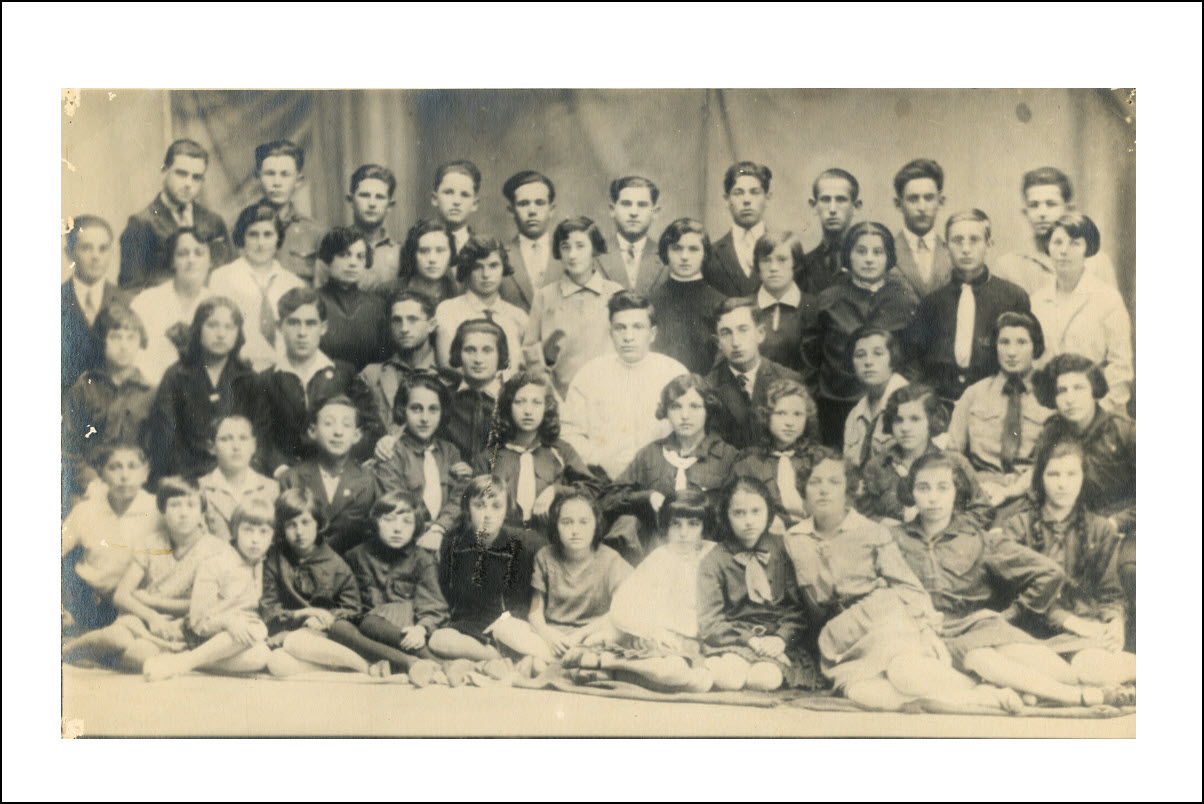 Elul 16, 5688 (September 1, 1928). Hashomer Hatzair nest in the city of Mlinov, leave-taking for the first emigration to the Land of Israel, Yehuda Mohel (sitting in the centre, wearing a white shirt). See additional photo identifications. Courtesy of Dani Tracz (Issachar Mohel).
Elul 16, 5688 (September 1, 1928). Hashomer Hatzair nest in the city of Mlinov, leave-taking for the first emigration to the Land of Israel, Yehuda Mohel (sitting in the centre, wearing a white shirt). See additional photo identifications. Courtesy of Dani Tracz (Issachar Mohel).The experience of heading to Mandate Palestine at the time was indeed challenging and is the only such account I know to date in English by a Mlinov youth.
Looking back later in life on himself as an idealistic young man from a provincial town, Yehuda's reflections are insightful and moving. He writes:We sailed from Trieste by ship in late October 1929, a group of members of Hashomer Hatzair. It was really a big part of the garin [seed, core] which was needed to build a kibbutz in the land of Israel. They were people with whom I had undergone the training period, but other members of Hashomer Hatzair went to other kibbutzim. We left the shores of Trieste in rough seas and in the dead of night heading for Israel. During one of the coldest mornings in November 1929 we approached the coast of Jaffa, but because Jaffa was not yet a suitable port, larger ships had to remain outside the area of the port in deep seas, because the water in the port was shallow. We were also delayed so we spent the morning off the Jaffa coast until rowboats came out to bring us to the shore. We arrived a few days after the dust had settled on the events of 1929 – although they were not settled entirely since the strike by the Arab dockworkers on the Jaffa coast still continued.
The first chapter ended with my aliyah to Israel in 1929. In general, I must say that at the time I made aliyah I was full of dreams which were based primarily around three main ideals. The first was Zionism, the second was socialism, and the third - perhaps unique to me - was vegetarianism. These were the three causes to which I gave my soul. I have to say that in those days I was very enthusiastic, but very naïve. Only later, after I had left my town to go out into the world, when I met with members in the kibbutz and with other people, was I able to make assessments and reach my conclusions. After all, I had been educated, brought up and had developed within the confines of a small town with narrow horizons, and so my own horizons were also extremely limited. My faith and ideals were emotionally profound, but I was still very innocent. The world I lived in formed a very narrow circle, and I settled into this circle. I must say that later on, when I compared myself with youths from other more developed cities, to say nothing of Warsaw - youths who had encountered different ideas and different directions in school, and later different shades of Zionism both to the left and to the right - their horizons were much broader than mine.[22]
***
The non-Partisan HeHalutz (also "HaChalutz")
While Hashomer Hatzair was the most popular youth group, there are also a few references to other youth groups in Mlynov and Mervits such as the group HeHalutz ("pioneer"). Harari recalls that initially:"Hashomir Hatsair" was the only youth organization in Mlynov. Consequently, they were responsible for all the Zionist and cultural activities in town. Later, 'Hachalutz' (The Pioneer) was created, and many members of 'Hashomir Hatsair” graduated to “Hachalutz” automatically. In addition, others who never belonged to “Hashomir Hatsair” joined “Hachalutz” because it was a new movement.
Unlike Hashomer Hatzair, which was socialist in orientation, HeHalutz (meaning "pioneer") was founded as a nonpartisan youth group. The movement had its roots in the early 20th century as early youth groups envisioned pioneers settling in the land of Israel, rendering service for the Jewish people, not with sword and the rifle, but with "spade and the plow." Such movements arose initially under a variety of names in various countries including Poland. The first conference of HeHalutz as a movement was in 1919 in Russia. With the suppression of all Zionist activities in the Soviet Union, the center of the movement shifted to Poland.The program of HeHalutz consisted of three basic aspects: organization, training ("hakhsharah"), and aliyah (emigration to the Land of Israel). In 1924, HeHalutz in Poland had a membership of 1,700; in 1925 – 4,600; 1930 – 11,600; 1933 – 41,000. In 1925, 712 members had enrolled in the training program. By 1935, that number had reached 7,915. In the late 1930s, HeHalutz helped organize the halutzim ("pioneers") as illegal immigrants, in their transportation to Palestine, and in the struggle for opening the gates of Palestine.[23]
Before we turn to the story of Betar, a latecomer on the scene of Jewish youth groups in Mlynov and Mervits, it is helpful to understand some of the factors contributing to the growing importance of Zionism and Zionist youth groups during this period. Understanding these factors provides a context for understanding the growth of this right-wing, semi-authoritarian youth group during this period.
Factors In Growth of Zionism in the Interwar Period
There were a number of reasons that Zionism grew in importance in Poland at this time. The 1917 Balfour declaration offering British support for a Jewish homeland gave the cause great prestige and optimism. In addition, the growing restrictions and eventual quotas on Eastern European immigration to the US in the 1920s significantly reduced the opportunity of immigration to the US, making Palestine one of the few options for those who wanted to leave. As we have seen, there was in fact a strong third wave of migration from Mlynov to the US right after the War between 1920–1923. After that, it became tougher to get into the United States. Between 1923–1925, those who left Mlynov and Mervits had to try to get into the US in roundabout fashion, via Argentina or Mexico, and a number of young men and a few young women succeeded in this way. After 1929, almost all migration from Mlynov to the US stopped, except for a few individuals who were successfully brought by family members who exerted pressure on local authorities from the US.
Both Polish antisemitism, and ironically Polish nationalism, each contributed in different ways to the growing importance of Zionism in Poland. It is easy to grasp how the growing Polish antisemitism helped nurture the Zionist movement and ideals, though perhaps not as obvious how Zionism was also the youths' emulation of Polish and European nationalism.
Polish Antisemitism
Antisemitism in Poland grew worse in the 1930s after Pilsudski passed away. Pilsudski, and the Sanacja party which had come to power with his coup in 1926, had been more tolerant of minority rights than the right wing Endek party, led by Demowski, which was deeply nationalistic and antisemitic. In the 1930s, antisemitic laws and violence increasingly got worse in the wake of the Depression and as fascism and right-wing authoritarianism swept across Europe. During this decade, Poland also began to build a relationship with the Nazi regime which it increasingly admired.Antisemitic laws and practices increased during the period and were expressed in religious, economic and social forms.[24] In support of its desire for Polish self-sufficiency, the government lent its support to unbridled economic antisemitism, including an official policy of promoting the cause of Jewish emigration. With obvious sarcasm and irony, Mendelsohn notes that "The Polish government did its best to soften British opposition to emigration to Palestine, and, if Zionism meant Jewish emigration to that country, no one was more Zionist than Poland's leaders in the late 1930s."[25] And of course Zionism embraced migration in part specifically because the ideology held that assimilation and acculturation would never succeed. Polish antisemitism helped confirm that sentiment.
Antisemitism between 1935–1939 expressed itself in many different ways. Jewish kosher slaughtering was outlawed, "ghetto benches" were created in Polish universities and physical attacks against Jewish students became more common. Economic antisemitism was increasingly serious and included the boycott of Jewish merchants and businesses. Christian businesses posted signs attesting to their Aryan nature. From 1936 on, pogroms were also revived. The growing antisemitism was abetted by the Catholic church and is spokespersons, which gave voice in its publications to the desire to remove Jews from Polish society.
Polish antisemitism thus called into question the liberals' strategy of integration and Polonization and gave credence to the Zionist message that Jews could never be equal partners in Polish society. But the causes of Zionism also flowed from Polish nationalism in another way.
The Zionist youth movement had grown strong already in the 1920s before antisemitism had dramatically increased when there was still more tolerance in Poland of minority rights and some hope that minorities could be integrated and accepted in Polish society. Zionist commitments, therefore, were not just reactions to antisemitism. They were also ironically emulations of Polish nationalism.
Polish Nationalism
Polish nationalism had blossomed with the rebirth of Poland and emphasized the importance of language, culture and nationality as part of a person’s identity. There were, however, two competing views of the Polish nation. Dmowski, the ideological leader of the Endek camp, had a nationalistic vision of a united, monocultural, and monoreligious Polish state which constrasted with Pilsudski's more liberal vision of a multiethnic, multireligious Poland, based on social justice.Jewish youth in the period were simultaneously drawn to Polish identity and pursued Polanization but were also aware that they were not and might never be fully accepted as Poles. These competing impulse appear in the autobiographies of Jewish youth during the period that were preserved by the YIVO institute and have been studied by researchers.[26] The celebration of Polish nationalism underscored the need for these youth to have their own version of national identity. Thus Zionism was in part an expression of the very same impulses that were producing Polish nationalism and antisemitism itself.
Somewhat paradoxically, nationalist impulses of this same kind made their way into some of the Zionist movements, such as Betar, which was accused by its critics of being fascist and whose members and leader, Jabotinsky, were drawn to some of the fascist impulses of Mussolini and of Polish nationalist leaders. As we shall see, at least some Mlynov and Mervits youth knew about and were involved in Betar, which positioned itself against the Socialist-Zionist youth group, Hashomer Hatzair, which was popular in Mlynov and Mervits. The complicated and paradoxical relationship that Betar had with the strident Polish Nationalism became evident in the way that the movement embraced and participated in Polish nationalist celebrations. The monocultural and racist Polish nationalism shared with Zionism the conviction that Jews should leave Poland and go to Palestine.[27] Some of these themes are visible in the reflections of Yehuda Mohel looking back on the development of his Zionist commitments:
There was a prevailing anti-Semitic sentiment, even though the Ukrainian peasants who came to the town generally lived in peace with the Jews. But even here, beneath the surface there was anti-Semitism, and the Polish authorities and institutions of the time tried to arouse it, to give it momentum and a practical expression like not buying from Jews, boycotting Jewish shops and so on. That was one side of it – the feeling of oppression throughout the country.
On the other side was the poor economic situation, especially in the Jewish towns. If there was no work in the city for the Poles, it was felt all the more so in the small towns among the Jews. None of the young Jews who reached adulthood, from the age of 15 on, could see a future ahead of them and they had no possibility of learning a profession in the educational institutions or of getting any job at all. The only option was, of course, emigration, and if emigration was the answer, then it would be to the land of Israel because of the oppression in Poland. And emigration came, first and foremost, from among the ranks of the Zionist movement.[28]
***
Familial and Intergenerational Tensions
While the Zionist activities were concentrated among the youth, not everyone in the older generation held Zionism at arm's length. We know that some adults, such as Moshe Fishman, got behind the idea of migration to Palestine. The Fishman family, as discussed earlier, was the first family to leave for Palestine in 1921 and their decision was big news in Mlynov at the time, a story told by Baruch Meren. Meren, who later immigrated to Palestine himself in 1938, recalled the event and the broad impact that it had at the time on the Mlynov residents, many of whom had doubts that the Fishmans would really do it. The Fishmans were part of the Third Aliyah, in which 40,000 Jews emigrated up to the Land of Israel between 1921 and 1923.[29]
According to Moshe's own account, he came under the Zionist influence of his boss, who ran a construction business and who eventually came to Palestine in the 1930s.[30] As noted earlier, Moshe’s younger son, Ben Fishman, made the decision to immigrate to US a year earlier. The split in the Fishman family between immigration to the US and aliyah to the land of Israel was symptomatic of differing choices and views at the time in the community and the changing circumstances that over time would make Zionism surpass US immigration as the primary option for those who wanted to leave. The split in the Fishman family was not the only instance of familial tensions over Zionism that is remembered.
Intergenerational tension over Zionist youth groups is also recalled by descendants of the Steinberg family from Mervits.
Bunia Steinberg
Shoshana (Upstein) Baruch recounts that her mother Bunia (Steinberg) Upstein, who grew up in Mervits, was very interested in Zionist activities as a teenage woman and was in love with another young man named Shmuel (not the Shmuel Mandelkern) from one of the Zionist youth groups. But Bunia’s grandfather, Eliezer Steinberg, frowned upon her interest in Zionist youth activities and wanted to marry her off through an arranged marriage to a suitable young man. Shoshana recounts the story:My maternal grandfather, Eliezer [Steinberg], guardian of the family, had little sympathy for the Zionist activities of my mother and wanted her to be arranged to be married to one of the boys of the town. He was strongly against the idea of making aliyah to the land [of Israel] and regarded all of my mother’s Zionist activities as a waste of time and stupidity. Even though my mother passed the necessary exams required to receive a certificate (documents to be admitted to the Yishuv land of Israel), she was not able to bring it to fruition because of grandfather’s opposition and the necessity of [her sister] Faiga needing her help. Faiga got married before the War, had two children and dwelled in Varkovitch with her husband, her mother-in-law, and her children. My mother traveled to Varkovitch often to help out her sister. [Varkovitch likely refers to Varkovychi, Ukraine, near Dubno.][31]
We can see here the faultlines emerging between the generations, with the older generation wanting to "arrange an appropriate marriage" and the younger generation wanting to marry for love those peers who shared their Zionist activities and aspirations. The reason that Bunia’s grandfather, Eliezer, was so involved in her life at this point in time, and not her father Anshel, illustrates another challenging dimension of life in the small towns of Mlynov and Mervits. There was a lack of adequate medical care and her father, who had become the butcher and shocket, had recently died. Shoshana writes:
After they settled down anew [after WWI], my grandfather Anshel [Steinberg] took council with the rabbi about whether to open a butcher shop and the rabbi counseled against it. Despite the advice, my grandfather opened the butcher shop. Things went well and and it appeared they would be able to support themselves. The family was relieved but a disaster struck the family after a time that turned the situation upside down. My grandfather cut his hand and was taken to the hospital in the nearby city. In those days there was no antibiotics, my grandfather’s wound got infected and he passed away when he was in his forties. The children were not told of the passing of their father, but when they came to take his tallit (prayer shawl) my mother grasped what had happened, cried and sobbed and wouldn’t let them take the tallit.
As noted earlier, when I learned the story of Anshel Steinberg's death, it dawned on me that Anshel's death might have been the reason that Yehuda Mohel's father Elizer heard about an opening in Mlynov for a shochet. It may have been Anshel's death that opened up that position.In any case, Anshel's death left Bunia to deal with her grandfather's feelings about Zionist activities. Despite her grandfather’s dislike of her Zionist activities, Bunia took a leadership role in Zionist activities in Mervits, which illustrates how the younger generation did not feel bound by the views of the older. Shoshana writes:
My mother was also influenced by Zionist impulses in the air; when she reached her teenage years, she joined the Betar movement and became active in Zionist activities. My mother’s home became a center for social and Zionist activities. The members of the movement came to her house to listen to the radio, and engage in discussions and the house became very active and full of life. In addition to taking care of her household responsibilities, my mother went to speeches of Jabotinsky in Dubno and Rovno, she participated in discussions and debates over the importance of making aliyah to the Land of Israel, and in outings with the youth movement and she hoped she too would be able to fulfill the Zionist idea.[32]
Betar, as we shall now see, differentiated itself in important ways from the Socialist-Zionist leaning organization Hashomer Hatzair.***
Betar and Revisionism Reach Mlynov and Mervits
It is significant to learn that the youth group, Betar, had made its way to Mlynov and Mervits and that young women, such as Bunia Steinberg, were able to go all the way to Dubno and Rovno to hear Jabotinsky, a sign of increased mobility and interaction among the youth of this period, a relaxation of strictures on young women, and an indication that the Mlynov and Mervits youth were aware of this right-wing movement within Zionism. Perhaps Bunia saw or heard about Jabotinsky on his 1927 trip to Poland in which he drew hundreds to his lectures, and which began a turning point in the growth of Revisionism in Poland. It was during this first trip that Jabotinsky realized the potential of the Polish youth for his brand of right-wing Zionism.Litvak recalls that Betar got going in Mlynov in the 1930s. "Due to the overwhelming popularity of the youth movements, another club was formed in addition to 'Hashomir Hatsair'. It was named 'Betar' in honor of an Israeli war hero. During 1931-1932, Betar began to sponsor Hachsharah, which was a work farm that prepared people to work on a kibbutz."[33] Meir Teitelman recalls tension over Betar in particular. "We had in our town the right Zionist party, 'Beytar', there were always disputes quarrels and even fights between the members of different Zionist organizations." [34]
It is not surprising that Betar generated controversy in the community when one knows more about its history. Jabotinsky, who had been born in Odessa, in an assimilated family, left the mainstream Zionist movement in 1923 due to differences of opinion between him and its chairman, Chaim Weizmann. He established a new revisionist party called Alliance of Revisionists-Zionists and its youth movement, Betar. Revisionists had a number of differences with mainstream Zionists in ideology and tone. They were against socialism which focused on class and they promoted military values of discipline, submerging the self into the nation, and arming oneself, that were reminiscent of fascist ideas and those of Polish nationalism. The Revisionists wanted the mainstream Zionist movement to recognize as its stated objective the establishment of a Jewish state on both banks of the Jordan River.
Betar was a youth group founded by Jabotinsky at a meeting of Jewish youth in Riga, Latvia in 1923. Jabotinsky proposed creating Betar to foster a new type of Jew thoroughly indoctrinated in his nationalist ideals and trained for military action against all enemies of Judaism. In a number of its ideas and emphases, Revisionism struck some of its critics as extreme, and some of the its members openly acknolwedged respect for fascist ideology. [35]
The name Betar was symbolic of military resistance in two ways. Betar was named for the last Jewish fort to fall in the Bar Kochba war against the Romans in the first century. It is also an acronym for the name Joseph Trumpedor, an early Zionist activist who helped to organize the Zion Mule Corps and bring Jewish immigrants to Palestine. Trumpeldor had himself lost an arm in the Russo-Japan war and had died defending the settlement of Tel Hai in 1920 with the words, "Never mind, it is good to die for our country". He subsequently became a Zionist national hero and a role model for Betar, even though he himself was a Socialist Zionist and promoted collaboration among the different youth organizations.[36]
NOTES
[1] On the general feeling of peer pressure to join youth groups in this period, see Alina Cala, "The Social Consciousness of Young Jews,"42–65. in Jews in Independent Poland 1918–1939 . Ed. Antony Polonsky, Ezra Mendelsohn, and Jerzy Tomaszewski. Part of the Series: Studies in Polish Jewish Polin. London: Litman Library of Jewish Civilization. Vol. 8. See also, Litvak's comments are from Joseph Litvak, "The Town of Mlynov," Mlynov-Muravica Memorial Book, 53–59; ↩[2] See Litvak, "The Town of Mlynov," Mlynov-Muravica Memorial Book, p. 53;↩[3] I learned about Joseph Litvak's background via an electronic message from his son Meir Litvak on 4/9/2020. I am grateful to Meir for providing the information and to Pavel Bernshtam, a Lamdan descendant, for connecting me to Meir. ↩[4] Personal communication from Meir Litvak on 4/9/2020.↩[5] A Gelman, "Our Small Town Is No More," Mlynov-Muravica Memorial Book, 44–45.↩[6] Yaffa Dayagi, "Home and Youth Movement in Mlynov," Mlynov-Muravica Memorial Book, 247–250.↩[7] Aaron Harari from Merhavia, "Culture, Education and Society in Town." Mlynov-Muravica Memorial Book 66–68. ↩[8] Aaron Harari from Merhavia, "Culture, Education and Society in Town." Mlynov-Muravica Memorial Book 66–68. ↩[9] Litvak, "The Town of Mlynov," Mlynov-Muravica Memorial Book, 53–59. ↩[10] Yaakov Holtzeker, "My Hometown Mlynov," Mlynov-Muravica Memorial Book, 226-228. ↩[11] The date of Samuel Mandelkern's immigration is mentioned in Litvak, "The Town of Mlynov," 53–59, and also recalled by Yehuda Mohel in his account below. ↩[12] The story of Yehuda Mohel is recounted in Riva and Yehuda: Life Story of Trancman, Mohel, Tracz and Ben-Eliezer Families, 2015. Trans. from Hebrew by Lynda Schwartz. D.C.P. Haifa, Tel Aviv, Israel, 2017. The section on Mlynov starts on page 35. The book is available for download.↩[13] Samuel Mendelkern from Tel Aviv, "Self Defense in Mlynov," Mlynov-Muravica Memorial Book, 116-146.↩[14] Litvak, "The Town of Mlynov," p. 53. ↩[16] Litvak, "The Town of Mlynov," p. 53. ↩[17] On the background of this movement, see Elkana Margalit, "Social and Intellectual Origins of the Hashomer Hatzair Youth Movement, 1913-20," Journal of Contemporary History 4:2 (1969):25-46. Accessed April 4, 2020. See also "Hashomer Hatzair," in Wikipedia and "Hashomer Hatzair," in Jewish Virtual Library. ↩[18] Aaron, Harari, "The Youth Movement "Hahomir Hatsair," Mlynov-Muravitz Memorial Book, 69-74. ↩[19] See previous note. ↩[20] See Dani Tracz (Issachar Mohel) Riva and Yehuda , 2015. Trans. from Hebrew by Lynda Schwartz. D.C.P. Haifa, Tel Aviv, Israel, 2017. The section on Mlynov starts on page 35. The book is available for download. ↩[21] For a more detailed account of the early context of the movement, see Margalit, Elkana. "Social and Intellectual Origins of the Hashomer Hatzair Youth Movement, 1913-20." Journal of Contemporary History 4:2 (1969):25-46. Accessed April 4, 2020. ↩[22] Dani Tracz (Issachar Mohel) Riva and Yehuda , 122. ↩[23] See I. Oppenheimer, "'Hehalutz' in Eastern Europe between the Two World Wars," Zionist Youth Movements during the Shoa (1996), 33–116; and "The Ideological Background of the 'Hehalutz' Movement in Russia and Poland in the 1920s," in: Polin 5 (1999), 131–55. See also "HeHalutz" in Jewish Virtual Library . ↩[24] The story of antisemitism in Poland is complex and spanned different sectors of the nation. My account draws on the useful and balanced summary of Ezra Mendlesohn, Jews of East Central Europe, 32–43, and especially 68–81. More detailed specific analyses are available. The following are helpful to grasp the complexity and diversity of Polish antisemitism causes and expressions. Jerzy Tomaszewski, "The Civil Rights of the Jews in Poland, 1918–1939," 115–127; Franciszek Adamski, "The Jewish Question in Polish Religious Periodical in the Second Republic: The Case of the Przeglad Katolicki," 129–145; Anna Landau-Czajka, "The Image of the Jew in the Catholic Press," 146–175.It should be noted that is a debate in the scholarly literature over how much Jew hatred was worse than the treatment of other minorities. For a view that Polish Jew hatred was worse than discrimination of other minorities, see for example, Yisrael Gutman, "Polish Antisemitism Between the Wars: An Overview," 97–108 In The Jews of Poland Between Two World Wars . Ed. Yisrael Gutman, Ezra Mendelsohn, et. al. For an alternative less polemical account, see Mendelsohn,Jews of East Central Europe, 32–43, and 68–81. ↩[25] Mendelsohn, The Jews of Central Europe, p. 71. ↩[26] Alina Cala, "Social Consciousness of Young Jews In Interwar Poland," 42-66; Mendelsohn, The Jews of Central Europe, 48.↩[27] See Mendelsohn,The Jews of Central Europe, p. 71. On the relationship of Zionism and Polish Nationalism and Fascism, see especially Jabotinsky's children. A really powerful and interesting book on this topic is Daniel Kupfert Heller, Jabotinsky's Children: Polish Jews and the Rise of Right-Wing Zionism. Princeton: Princeton Universitstunningy, 2017. ↩[28] See Dani Tracz (Issachar Mohel), Riva and Yehuda, 60. ↩[29] See, for example, Wikipedia article on " Third Aliyah." ↩[30] Moshe Fishman, "Mlynov in the Past," Mlynov-Muravica Memorial Book 60–62. ↩[31] Shoshana (Upstein) Baruch, A Struggle to Survive:Stories of Bunia and Yitzhak Upstein, 14. Original published in Hebrew. Trans. by Charles Epstein with Howard I. Schwartz can be downloaded in PDF. Shoshana and Charles are the children of Bunia (Steinberg) Upstein, who was born in Mervits and whose story is told here. Howard I. Schwartz is a descendent of the Gruber, Demb, Schwartz and Shulman families from Mlnov. On Varkovychi, Ukraine, see JewishGen. ↩[32] Shoshana Baruch, A Struggle to Survive, 17. See prior note for download. ↩[33] See Litvak, "The Town of Mlynov," Mlynov-Muravica Memorial Book, 53-59; ↩[34] S.M.T (Sonia and Mendel Teitelman), Joys and Sorrows in Mervits," Mlynov-Muravica Memorial Book, pp. 167-180. ↩[35] See Daniel Kupfert Heller, Jabotinsky's Children. ↩***
Additional Reading
For additional reading, see the list of bibliographical resources for Interwar Poland.***
Compiled by Howard I. Schwartz
Updated:August 2024
Copyright © 2019 Howard I. Schwartz
Webpage Design by Howard I. Schwartz
Want to search for more information: JewishGen Home Page
Want to look at other Town pages: KehilaLinks Home Page
This page is hosted at no cost to the public by JewishGen, Inc., a non-profit corporation. If it has been useful to you, or if you are moved by the effort to preserve the memory of our lost communities, your JewishGen-erosity would be deeply appreciated.
- History

